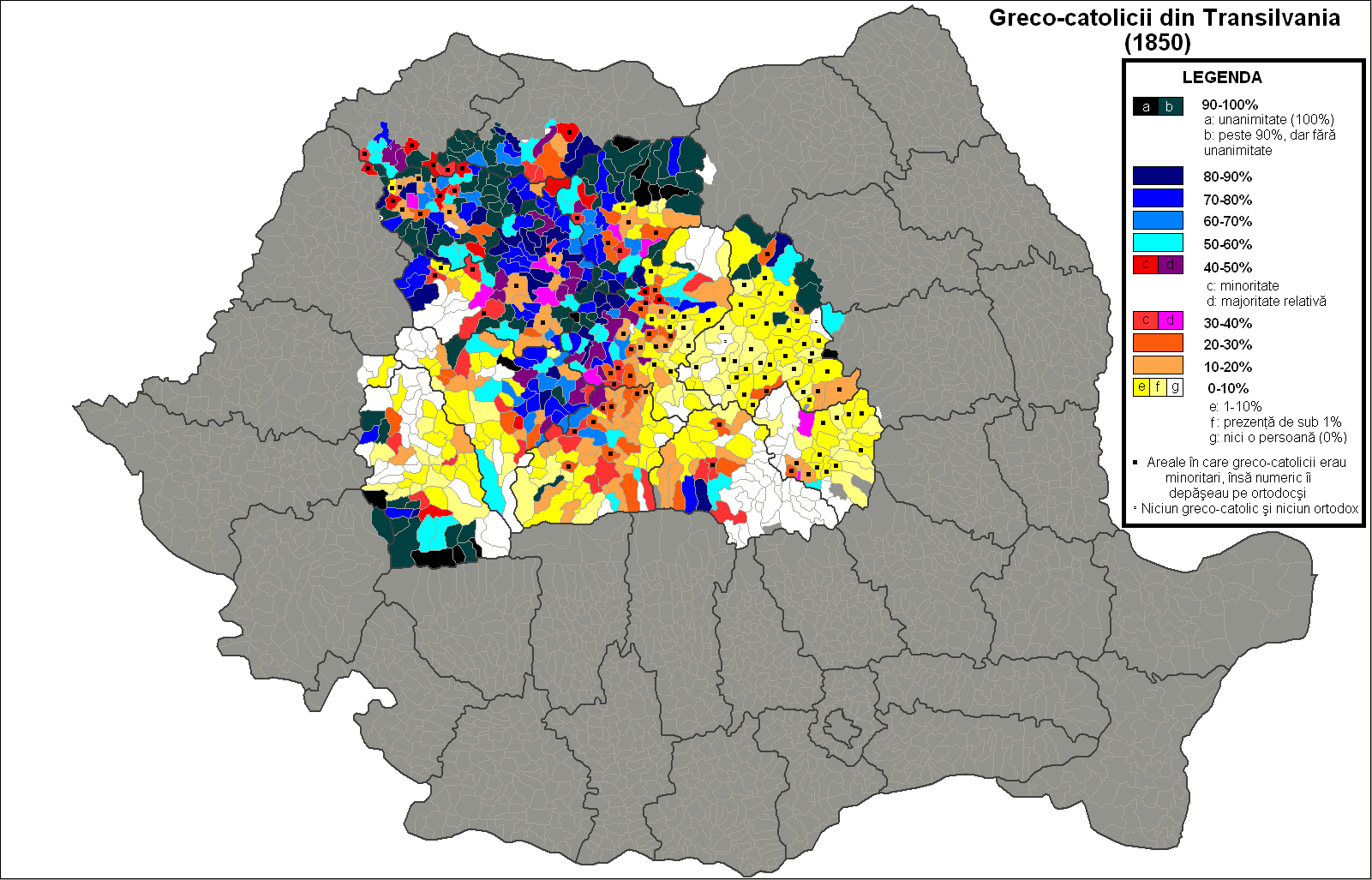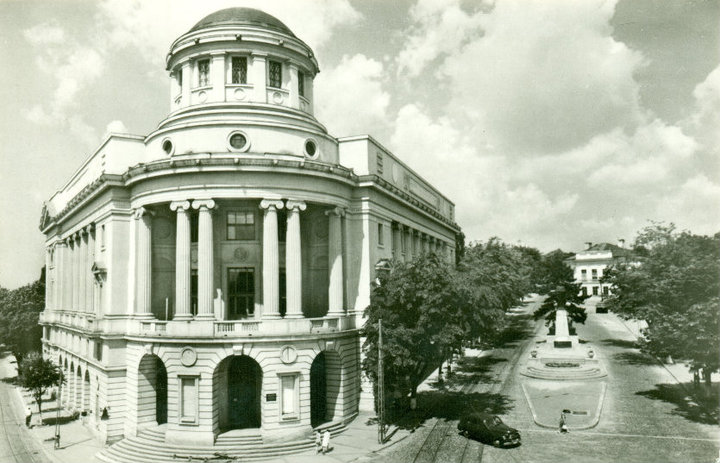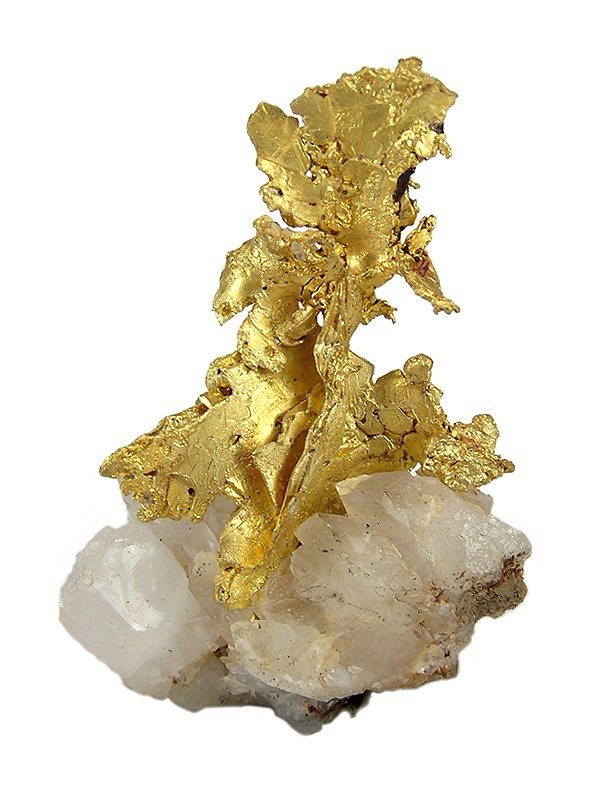|
Blaj
Blaj (; archaically spelled as ''Blaș''; ; ; Transylvanian Saxon: ''Blußendref'') is a city in Alba County, Transylvania, Romania. It has a population of 17,816 inhabitants as of 2021. The city administers eight villages: Deleni-Obârșie (''Obursatanya''), Flitești, Izvoarele (until 1960 ''Ciufud''; ''Csufud''), Mănărade (''Monora''), Petrisat (''Magyarpéterfalva''), Spătac (''Szászpatak''), Tiur (''Tűr''), and Veza (''Véza''). The city was the principal religious and cultural center of the Romanian Greek-Catholic Church in Transylvania. History Blaj is first mentioned in 1271 as ''Villa Herbordi'', after the deed of a Count Herbod. In 1313, the domain passed to Herbod's son Blasius Cserei and the town was mentioned as ''Blasii''. Started as a hamlet for the twenty families of servants of the noble's court, it was awarded town status on May 19, 1737. Blaj is the principal religious and cultural center of Greek Catholics in Transylvania. At 27 October 1687 begins th ... [...More Info...] [...Related Items...] OR: [Wikipedia] [Google] [Baidu] |
Cathedral Of The Holy Trinity, Blaj
The Cathedral of the Holy Trinity () in Blaj, Romania is a Romanian Greek Catholic cathedral commissioned by bishop Inocențiu Micu-Klein in 1738. The church was built by Viennese architect An architect is a person who plans, designs, and oversees the construction of buildings. To practice architecture means to provide services in connection with the design of buildings and the space within the site surrounding the buildings that h ...s Anton Erhard Martinelli and Johann Baptist Martinelli, being completed in 1749. The building was extended in 1838, when the two monumental towers were added. References B Baroque church buildings in Romania B Tourist attractions in Alba County Blaj Churches completed in 1749 18th-century Catholic church buildings Romanian Greek Catholic Major Archeparchy of Făgăraș and Alba Iulia {{RomanianGreekCatholic-church-stub ... [...More Info...] [...Related Items...] OR: [Wikipedia] [Google] [Baidu] |
Romanian Church United With Rome, Greek-Catholic
The Romanian Greek Catholic Church or Romanian Church United with Rome is a ''sui iuris'' Eastern Catholic Church, in full union with the Catholic Church. It has the rank of a Major Archbishop, Major Archiepiscopal Church and it uses the Byzantine Rite, Byzantine liturgical rite in the Romanian language. It is part of the Major Archiepiscopal Churches of the Catholic Church that are not distinguished with a patriarchal title. Cardinal Lucian Mureșan, Archbishop of Greek Catholic Archdiocese of Făgăraș and Alba Iulia, Făgăraș and Alba Iulia, has served as the head of the Romanian Greek-Catholic Church since 1994. On December 16, 2005, as the ''Romanian Church United with Rome'', the Greek-Catholic church was elevated to the rank of a Major Archiepiscopal Church by Pope Benedict XVI, with Lucian Mureșan becoming its first major archbishop. Mureşan was made a cardinal, at the papal consistory, consistory of February 18, 2012. Besides the Archeparchy of Făgăraș and Alba ... [...More Info...] [...Related Items...] OR: [Wikipedia] [Google] [Baidu] |
Câmpia Libertății
Câmpia Libertății (''The Field of Liberty'') is located in the city of Blaj, in Transylvania, Romania. It was the place where two national assemblies were held during the 1848 Revolution, the first one in May, and the second one in September. The was held here on May 15, 1848, with the participation of some 30–40,000 people. A sculptural-monumental ensemble rises on the field, composed of a central monument called the "Glory" and 26 busts depicting the heads of the 1848 Revolution and remarkable figures of Romanian culture. Important sculptors such as , Ion Irimescu, Ion Jalea, and contributed to the monument. On June 2, 2019, seven Greek-Catholic Romanian bishops who were martyred under the communist regime (Vasile Aftenie, Ioan Bălan, Tit Liviu Chinezu, Valeriu Traian Frențiu, Iuliu Hossu, Alexandru Rusu, and Ioan Suciu) were beatified by Pope Francis Pope Francis (born Jorge Mario Bergoglio; 17 December 1936 – 21 April 2025) was head of the Catholic Chur ... [...More Info...] [...Related Items...] OR: [Wikipedia] [Google] [Baidu] |
Târnava Mare
The Târnava Mare ("Great Târnava"; ; ) is a river in Romania. Its total length is and its basin size is . Its source is in the Eastern Carpathian Mountains, near the sources of the Mureș and Olt in Harghita County. It flows through the Romanian counties of Harghita, Mureș, Sibiu, and Alba. The cities of Odorheiu Secuiesc, Sighișoara, and Mediaș lie on the Târnava Mare. It joins the Târnava Mică in Blaj, forming the Târnava. Towns and villages The following towns and villages are situated along the river Târnava Mare, from source to mouth: Sub Cetate, Zetea, Brădești, Odorheiu Secuiesc, Feliceni, Mugeni, Porumbeni, Cristuru Secuiesc, Secuieni, Sighișoara, Daneș, Dumbrăveni, Dârlos, Mediaș, Copșa Mică, Micăsasa Micăsasa (; ) is a commune located in Sibiu County, Transylvania, Romania. It is composed of four villages: Chesler (''Kesseln''; ''Keszlér''), Micăsasa, Țapu (''Abtsdorf an der Kokel''; ''Csicsóholdvilág''), and Văleni (''Huru ... [...More Info...] [...Related Items...] OR: [Wikipedia] [Google] [Baidu] |
Târnava Mică
The Târnava Mică ("Small Târnava"; ; ) is a river in Romania. Its total length is , and its drainage basin area is . Its source is in the Eastern Carpathian Mountains, in Harghita County. It flows to the west through the Romanian counties Harghita, Mureș, and Alba, more or less parallel to and north from the Târnava Mare. The cities of Sovata and Târnăveni lie on the Târnava Mică. It joins the Târnava Mare in Blaj, forming the Târnava. e-calauza.ro Towns and villages The following towns and villages are situated along the river Târnava Mică, from source to mouth: Praid, Sovata,[...More Info...] [...Related Items...] OR: [Wikipedia] [Google] [Baidu] |
Romanians
Romanians (, ; dated Endonym and exonym, exonym ''Vlachs'') are a Romance languages, Romance-speaking ethnic group and nation native to Central Europe, Central, Eastern Europe, Eastern, and Southeastern Europe. Sharing a Culture of Romania, common culture and Cultural heritage, ancestry, they speak the Romanian language and live primarily in Romania and Moldova. The 2021 Romanian census found that 89.3% of Romania's citizens identified themselves as ethnic Romanians. In one interpretation of the 1989 census results in Moldova, the majority of Moldovans were counted as ethnic Romanians as well.''Ethnic Groups Worldwide: A Ready Reference Handbook By'' David Levinson (author), David Levinson, Published 1998 – Greenwood Publishing Group.At the time of the 1989 census, Moldova's total population was 4,335,400. The largest nationality in the republic, ethnic Romanians, numbered 2,795,000 persons, accounting for 64.5 percent of the population. Source U.S. Library of Congres ... [...More Info...] [...Related Items...] OR: [Wikipedia] [Google] [Baidu] |
Mihai Eminescu
Mihai Eminescu (; born Mihail Eminovici; 15 January 1850 – 15 June 1889) was a Romanians, Romanian Romanticism, Romantic poet, novelist, and journalist from Moldavia, generally regarded as the most famous and influential Romanian poet. Eminescu was an active member of the Junimea literary society and worked as an editor for the newspaper ''Timpul'' ("The Time"), the official newspaper of the Conservative Party (Romania, 1880–1918), Conservative Party (1880–1918). His poetry was first published when he was 16 and he went to Vienna, Austria to study when he was 19. The poet's manuscripts, containing 46 volumes and approximately 14,000 pages, were offered by Titu Maiorescu as a gift to the Romanian Academy during the meeting that was held on 25 January 1902. Notable works include ''Luceafărul (poem), Luceafărul'', ''Odă în metru antic'' (''Ode in Ancient Meter''), and the five ''Letters'' (''Epistles/Satires''). In his poems, he frequently used metaphysical, mythological ... [...More Info...] [...Related Items...] OR: [Wikipedia] [Google] [Baidu] |
Transylvanian School
The Transylvanian School () was a cultural and political movement which started after part of the Romanian Orthodox Church in Habsburg-ruled Transylvania accepted the leadership of the pope and became the Greek-Catholic Church (). The links with Rome brought to the Romanian Transylvanians the ideas of the Age of Enlightenment. It was the main political forum for Romanians in the Habsburg Empire and the main representative of Enlightenment in the history of Romania. Its main activity took place between 1785 and 1815. The leaders of the movement, also known as "coryphaei", were: Ion Budai-Deleanu, Samuil Micu-Klein, Petru Maior, and Gheorghe Șincai. Often cited along them are predecessors, mainly Inocențiu Micu-Klein, and numerous political personalities or scholars influenced by it, notably Gheorghe Lazăr, Aaron Florian, Timotei Cipariu, and Alexandru Papiu Ilarian. Other members were Ioan Piuariu-Molnar, Radu Tempea, Paul Iorgovici, Petru Pavel Aron, Gherontie Cotor ... [...More Info...] [...Related Items...] OR: [Wikipedia] [Google] [Baidu] |
Alba County
Alba County () is a county (județ) of Romania located in the historic region of Transylvania. Its capital is Alba Iulia, a city with a population of 63,536. Name "Alba", meaning "white" in Latin and Romanian, is derived from the name of the city of Alba Iulia. In Hungarian language, Hungarian, the county is known as ''Fehér megye'' (fehér also meaning white), and in German language, German as ''Kreis Karlsburg''. Geography This county has a total area of , with mountains occupying about 59% of its surface. The Apuseni Mountains are in the northwest; the northeastern side of the Parâng Mountains group – the Șureanu Mountains, Șureanu and Cindrel Mountains, Cindrel mountains – are in the south. In the east there is the Transylvanian Plateau with deep but wide valleys. The three main elements are separated by the Mureș (river), Mureș River valley. The main rivers are the Mureș (river), Mureș River and its tributaries, the Târnava, the Sebeș (river), Sebeș, ... [...More Info...] [...Related Items...] OR: [Wikipedia] [Google] [Baidu] |
Târnava
The Târnava (full name in ; ; ; ) is a river in Romania. It is formed by the confluence of the Târnava Mare and Târnava Mică in the town of Blaj. The Târnava flows into the Mureș after 23 km near the town of Teiuș. The two source rivers of the Târnava are the Târnava Mare and Târnava Mică, and its tributaries include the Tur, Izvorul Iezerului, Secaș, and the Dunărița. Its drainage basin covers an area of .Analysis of the Tisza River Basin 2007 IPCDR Etymology The name Târnava is of[...More Info...] [...Related Items...] OR: [Wikipedia] [Google] [Baidu] |
Municipiu
A municipiu (from Latin ''municipium''; English: municipality) is a level of administrative subdivision in Romania and Moldova, roughly equivalent to city in some English-speaking world, English-speaking countries. In Romania, this status is given to towns that are large and urbanized; at present, there are 103 ''municipii''. There is no clear benchmark regarding the status of ''municipiu'' even though it applies to localities which have a sizeable population, usually above 15,000, and extensive urban infrastructure. Localities that do not meet these loose guidelines are classified only as towns (''orașe''), or if they are not urban areas, as Commune in Romania, communes (''comune''). Cities are governed by a mayor and local council. There are no official administrative subdivisions of cities even though, unofficially, municipalities may be divided into quarters/districts (''cartiere'' in Romanian language, Romanian). The exception to this is Bucharest, which has a status simila ... [...More Info...] [...Related Items...] OR: [Wikipedia] [Google] [Baidu] |
Transylvania
Transylvania ( or ; ; or ; Transylvanian Saxon dialect, Transylvanian Saxon: ''Siweberjen'') is a List of historical regions of Central Europe, historical and cultural region in Central Europe, encompassing central Romania. To the east and south its natural border are the Carpathian Mountains and to the west the Apuseni Mountains. Broader definitions of Transylvania also include the western and northwestern Romanian regions of Crișana and Maramureș, and occasionally Banat. Historical Transylvania also includes small parts of neighbouring Western Moldavia and even a small part of south-western neighbouring Bukovina to its north east (represented by Suceava County). Transylvania is known for the scenery of its Carpathian landscape and its rich history, coupled with its multi-cultural character. It also contains Romania's second-largest city, Cluj-Napoca, and other very well preserved medieval iconic cities and towns such as Brașov, Sibiu, Târgu Mureș, Bistrița, Alba Iuli ... [...More Info...] [...Related Items...] OR: [Wikipedia] [Google] [Baidu] |



